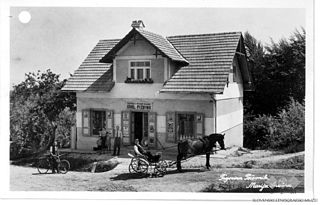| Trate | |
|---|---|
| Coordinates: 46°42′4.68″N15°47′15.99″E / 46.7013000°N 15.7877750°E Coordinates: 46°42′4.68″N15°47′15.99″E / 46.7013000°N 15.7877750°E | |
| Country | |
| Traditional region | Styria |
| Statistical region | Drava |
| Municipality | Šentilj |
| Area | |
| • Total | 4.47 km2 (1.73 sq mi) |
| Elevation | 336.3 m (1,103.3 ft) |
| Population (2002) | |
| • Total | 322 |
| [1] | |
Trate (pronounced [ˈtɾaːtɛ] ) is a settlement in the Slovene Hills (Slovene : Slovenske gorice) in the Municipality of Šentilj in northeastern Slovenia. [2]

The Slovene Hills or the Slovenian Hills is the largest hilly region of Slovenia, a smaller part is located in the Austrian province of Styria. It is situated in the northeast of the country and has an area of 1,017 square kilometres (393 sq mi). It comprises the Western Slovene Hills and the Eastern Slovene Hills. The region is known for its vineyards and wines. The central town and municipality is Lenart.

Slovene or Slovenian belongs to the group of South Slavic languages. It is spoken by approximately 2.5 million speakers worldwide, the majority of whom live in Slovenia. It is the first language of about 2.1 million Slovenian people and is one of the 24 official and working languages of the European Union.

A municipality is usually a single administrative division having corporate status and powers of self-government or jurisdiction as granted by national and regional laws to which it is subordinate. It is to be distinguished (usually) from the county, which may encompass rural territory or numerous small communities such as towns, villages and hamlets.
Cmurek Castle is an originally 12th-century castle built on a hill above the Mura River in the northern part of the settlement. It was extended and rebuilt at various times in the 16th, 17th, and late 18th centuries. It is a three-story building with an internal arcaded courtyard. [3]

An arcade is a succession of contiguous arches, with each arch supported by columns, piers. Exterior arcades are designed to provide a sheltered walkway for pedestrians. The walkway may be lined with retail stores. An arcade may feature arches on both sides of the walkway. Alternatively, a blind arcade superimposes arcading against a solid wall. Blind arcades are a feature of Romanesque architecture that influenced Gothic architecture. In the Gothic architectural tradition, the arcade can be located in the interior, in the lowest part of the wall of the nave, supporting the triforium and the clerestory in a cathedral, or on the exterior, in which they are usually part of the walkways that surround the courtyard and cloisters.

A courtyard or court is a circumscribed area, often surrounded by a building or complex, that is open to the sky. Such spaces in inns and public buildings were often the primary meeting places for some purposes, leading to the other meanings of court. Both of the words court and yard derive from the same root, meaning an enclosed space. See yard and garden for the relation of this set of words.



